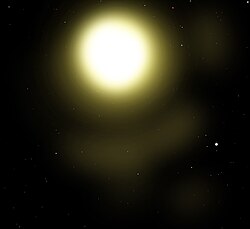Delta Canis Majoris
Delta Canis Majoris Media
 <div style="position: absolute; z-index: 2; height: 0; width: 0; margin: 0; padding: 0; <div style="position: absolute; z-index: 2; height: 0; width: 0; margin: 0; padding: 0;
top: Expression error: Unexpected * operator.px; left: Expression error: Unexpected * operator.px; "> <div style="position: relative; z-index: 3; line-height: 0; text-align: center; width: px; left: -Expression error: Unexpected / operator.px;top: -Expression error: Unexpected / operator.px;">[[File:|px||link=]] | |
| Observation data Epoch J2000 Equinox J2000 | |
|---|---|
| Constellation | Canis Major |
| Right ascension | 07h 08m 23.48608s |
| Declination | −26° 23′ 35.5474″ |
| Apparent magnitude (V) | 1.824 |
| Characteristics | |
| Spectral type | F8Ia |
| Astrometry | |
| Distance | 1600 ly |
| Details | |
| Mass | 12 M☉ |
| Radius | 215 R☉ |
| Luminosity | 82,000 L☉ |
| Surface gravity (log g) | 1.14 cgs |
| Temperature | 6,390 K |
| Metallicity [Fe/H] | 0.24 dex |
| Rotational velocity (v sin i) | 25 km/s |
| Age | 12 Myr |
| Other designations | |
Delta Canis Majoris is a star in the constellation of Canis Major. It is a yellow-white F-type supergiant with an apparent magnitude of +1.83.
Since 1943, the spectrum of this star has been one of the stable anchor points by which other stars are classified.
Properties
Delta Canis Majoris is a supergiant of class F8 with a radius around 215 times that of the Sun.
Its surface temperature is 5,818 K, and it is 12 times more massive than the Sun. Its absolute magnitude is −6.87, and it is 1,600 light-years away. It is rotating at a speed of around 28 km/s, and so may take a year to rotate fully.
Only around 10 million years old, Delta Canis Majoris has stopped fusing hydrogen in its core, Its outer envelope is beginning to expand and cool, and in the next 100,000 years it will become a red supergiant as its core fuses heavier and heavier elements, Once it has an iron core, it will collapse and explode as a supernova.
If Delta Canis Majoris were as close to Earth as Sirius is, it would be as bright as a half-full moon.
